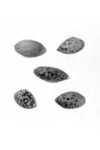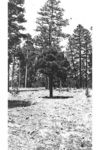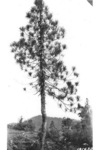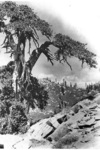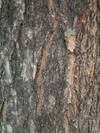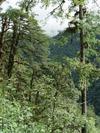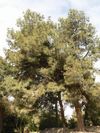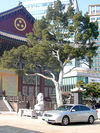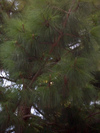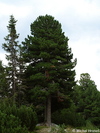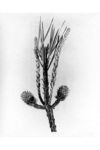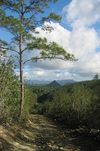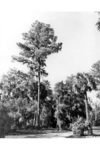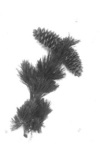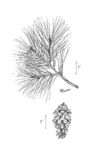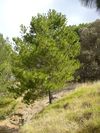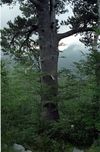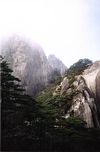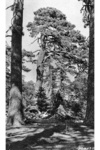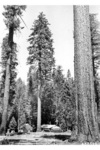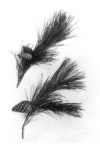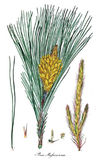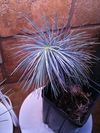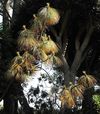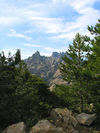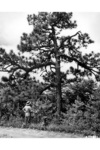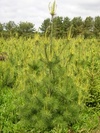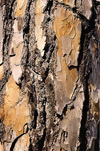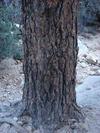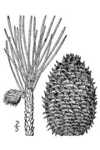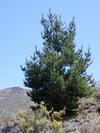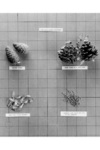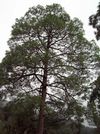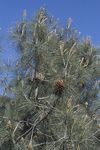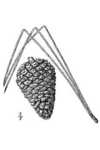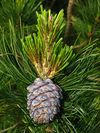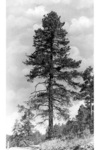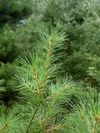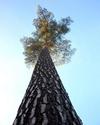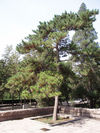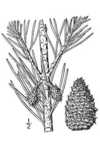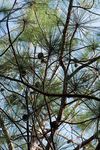Genus Pinus
Pines are trees in the genus Pinus , in the family Pinaceae.Species in the genus Pinus of plants
Whitebark pine - The Whitebark Pine is typically the highest-elevation pine tree of these mountains, marking the tree line. Thus, it is often found as krummholz, trees dwarfed by exposure and growing close to the ground. In more favourable conditions, trees may grow to 20 m in height, although some can reach up to 27 m.
Yakushima White Pine - The needles grow in bundles of five and the cones are 5-8 cm in length.
Rocky Mountains Bristlecone Pine - Pinus aristata is a medium-size tree, reaching 5-15 m tall and with a trunk diameter of up to 1.5 m. The bark is grey-brown, thin and scaly at the base of the trunk. The leaves are in fascicles of five, stout, 2.5-4 cm long, deep green to blue-green on the outer face, with stomata confined to a bright white band on the inner surfaces. The cones are ovoid-cylindrical, 5-10 cm long and 3-4 cm broad when closed, purple at first, ripening yellow-buff when 16 months old, with numerous thin, fragile scales, each scale with a bristle-like spine 4-8 mm long.
Arizona pine - Arizona Pine had been thought to be a variant of Ponderosa Pine by some botanists, but is now recognized as a distinct species by most authorities.
Armand pine - It is a member of the white pine group, Pinus subgenus Strobus, and like all members of that group, the leaves are in fascicles of five, with a deciduous sheath. They are 820 cm long. The cones are 922 cm long and 68 cm broad, with stout, thick scales. The seeds are large, 1016 mm long and have only a vestigial wing; they are dispersed by Spotted Nutcrackers. The cones mature in their second year, this is a juvenile female cone:
Knobcone pine - The Knobcone Pine crown is usually conical with a straight trunk. It reaches heights of 824 metres . however, it can be a shrub on especially poor sites. It prefers dry rocky mountain soils. The bark is smooth, flaky and gray-brown when young, becoming dark gray-red-brown and shallowly furrowed into flat scaly ridges. The twigs are red-brown and often resinous.
Mexican white pine - Pinus ayacahuite is a large tree, regularly growing to 30-45 m and exceptionally up to 50 m tall. It is a member of the white pine group, Pinus subgenus Strobus, and like all members of that group, the leaves are in fascicles of five, with a deciduous sheath. The needles are finely serrated, and 9-16 cm long. The cones are long and slender, 15-40 cm long and 4-6 cm broad , opening to 6-10 cm broad; the scales are thin and flexible. The seeds are small, 6-8 mm long, and have a long slender wing 18-25 mm long.
Foxtail pine - Foxtail Pine is a tree to 1020 m tall, exceptionally 35 m , and up to 2 m in trunk diameter. The leaves are needle-like, in bundles of five with a semi-persistent basal sheath, and 24 cm long, deep glossy green on the outer face, and white on the inner faces; they persist for 1015 years. The cones are 6-11 cm long, dark purple ripening red-brown, with soft, flexible scales each with a one millimetre central prickle.
Jack pine - Jack pines range from 922 m in height. Some jack pines are shrub-sized, due to poor growing conditions. They do not usually grow perfectly straight, resulting in an irregular shape similar to pitch pine . This pine often forms pure stands on sandy or rocky soil. It is fire-adapted to stand-replacing fires, with the cones remaining closed for many years, until a forest fire kills the mature trees and opens the cones, reseeding the burnt ground.
Bhutan pine - The needles are in bundles of five, up to 25 cm long. The cones are 1220 cm in length, with thin scales; the seeds are 56 mm long, with a 2025 mm wing. It differs from P. wallichiana in the much longer, strongly drooping needles, and the cones being slightly smaller and red-brown, rather than yellow-buff, when mature. It is also adapted to generally warmer, wetter climates at lower altitudes, with an intense summer monsoon. Despite the two being closely related and at least occasionally growing together, no hybrids or intermediates have ever been reported.
Turkish pine - Turkish Pine is also known by several other common names, Calabrian Pine , East Mediterranean Pine and Brutia Pine.
Lacebark Pine - It is used as an ornamental plant in East Asian classical garden where it symbolizes longevity.
Canary Island pine - The native range has been somewhat reduced due to over-cutting so that only the islands of Tenerife, La Palma and Gran Canaria still have large forests. It is the tallest tree in the Canary Islands.
Caribbean pine - The Caribbean Pine, Pinus caribaea, is a hard pine native to Central America, Cuba, the Bahamas, and the Turks and Caicos Islands. It inhabits tropical and subtropical coniferous forests, which include both lowland savannas and montane forests. Wildfire plays a major role limiting the range of this species, as it has been reported that this tree regenerates quickly and aggressively, replacing latifoliate trees. In zones not subject to periodic fires, the succession continues and a tropical forest thrives.
Arolla Pine - It is a member of the white pine group, Pinus subgenus Strobus, and like all members of that group, the leaves are in fascicles of five, with a deciduous sheath. The needle-like leaves are 5 centimetres to 9 centimetres long. The cones, which contain the seeds , of the Swiss Pine are 4 centimetres to 8 centimetres long. The 8 millimetres to 12 millimetres long seeds have only a vestigial wing and are dispersed by Spotted Nutcrackers.
Mexican pinyon - The range extends from westernmost Texas, United States , south through much of Mexico, occurring widely along the Sierra Madre Oriental and Sierra Madre Occidental ranges, and more rarely in the eastern Eje Volcαnico Transversal range. It lives in areas with little rainfall, which fluctuates between 380 millimetres to 640 millimetres , the subspecies orizabensis is found farther south in the state of Veracruz. There is also a disjunct population in the Sierra de la Laguna of southern Baja California Sur. It occurs at moderate altitudes, mostly from 1,600 metres to 2,400 metres .
Sand pine - The leaves are needle-like, in pairs, 510 cm long, and its cones are 48 cm long. Over much of its range, it is fire-adapted to stand-replacing wildfires, with the cones remaining closed for many years , until a natural forest fire kills the mature trees and opens the cones. These then reseed the burnt ground. Some populations differ in having cones that open at maturity, with seed dispersal not relying on fires.
Lodgepole pine - There are three subspecies of Pinus contorta, one of them with two varieties. All the four taxa are sometimes treated at the rank of variety.
Bigcone pine - The size ranges from 10-24 m tall, and a trunk diameter up to 1 m . The trunk is vertical and branches horizontal to upcurved. The leaves are needle-like, in bundles of three, glaucous gray-green, 15-30 cm long and stout, 2 mm thick. The outstanding characteristic of this tree is the large, spiny cones which are 20-40 cm long, and weigh 2-5 kg when fresh. Coulter Pines produce the largest cones of any pine tree species , although the slender cones of the sugar pine are longer. The large size of the cones has earned them the nickname "widowmakers" among locals. The wood is weak and soft, so that the species is little used other than for firewood. It is also occasionally planted as an ornamental tree in parks and large gardens.
Cuban Pine - The closely related Hispaniolan Pine , native to the neighboring island of Hispaniola, is treated as synonymous by some botanists.
Potosi Pinyon - It is a medium-size shrub, reaching 1.5-5 m tall and with a trunk diameter of up to 25 cm. The bark is grey-brown, thin and scaly at the base of the trunk. The leaves are in fascicles of five, slender, 3-5.5 cm long, and deep green to blue-green, with stomata confined to a bright white band on the inner surfaces.
Pinus dalatensis - Pinus dalatensis is a medium-sized evergreen tree growing to 3040 m tall. It is a member of the white pine group, Pinus subgenus Strobus, and like all members of that group, the leaves are in fascicles of five, with a deciduous sheath. The needles are finely serrated, and 514 cm long.
Gaoshan Pine - It is endemic-found only in China.
Japanese Red Pine - The leaves are needle-like, 812 cm long, with two per fascicle. The cones are 47 cm long. It is closely related to Scots Pine, differing in the longer, slenderer leaves which are mid green without the glaucous-blue tone of Scots Pine.
Michoacan pine - Pinus devoniana is a species of conifer in the Pinaceae family. It is found in Mexico - from S. Sinaloa to Chiapas - and Guatemala in montane, relatively open pine or pine-oak forests at altitudes from 900 to 2500 m.
Durango pine - It is related to Ponderosa Pine and included in the same subsection Ponderosae. It is an evergreen tree reaching 2540 m in height, with a trunk up to 1 m diameter and a broad, rounded crown. The bark is thick, dark gray-brown, and scaly or fissured. The leaves are needle-like, dark green, five to seven per fascicle , 1424 cm long and 0.7-1.1 mm wide, the persistent fascicle sheath 1.53 cm long. The cones are ovoid, 59 cm long, green ripening brown, opening when mature in spring to 56 cm broad. The seeds are winged, 56 mm long with a 1.5-2.5 cm wing. Pollination is in late spring, with the cones maturing 2022 months after.
Shortleaf pine - The leaves are needle-like, in bundles of two and three mixed together, and from 7-11 cm long. The cones are 4-7 cm long, with thin scales with a transverse keel and a short prickle. They open at maturity but are persistent.
Colorado pinyon - The range is in Colorado, southern Wyoming, eastern and central Utah, northern Arizona, New Mexico, and the Guadalupe Mountains in westernmost Texas. It occurs at moderate altitudes from 1,600 metres to 2,400 metres , rarely as low as 1,400 metres and as high as 3,000 metres . It is widespread and often abundant in this region, forming extensive open woodlands, usually mixed with junipers in the Pinyon-juniper woodland plant community. The Colorado pinyon grows as the dominant species on 4.8 million acres ) in Colorado, making up 22% of the state's forests. The Colorado pinyon has cultural meaning to agriculture, as strong piρon wood "plow heads" were used to break soil for crop planting at the state's earliest known agricultural settlements.
Slash pine - Pinus elliottii, commonly known as the Slash Pine, is a pine native to the southeastern United States, from southern South Carolina west to southeastern Louisiana, and south to the Florida Keys.
Pinus engelmannii - The branches are sparse and very stout, giving the tree a distinct appearance. The needles, among the longest of any pine, are in bundles of three , 20-40 cm long, stout, and spreading to slightly drooping. The cones are 8-16 cm long, green or purple when growing, maturing glossy brown, moderately oblique with stoutly spined scales on the outer side . The Apache pine sometimes shows a grass stage like the related Michoacan Pine and also Longleaf Pine .
Fenzel's White Pine - The Pinus fenzeliana leaves are needle-like, in fascicles of five, and 5-13 cm long. The cones are 6-11 cm long, with thick, woody scales; the seeds are large, about 8-15 mm long, with a vestigial 3 mm wing, similar to the related Chinese White Pine . Hainan White Pine differs from that species in the shorter needles, smaller cones, and in being adapted to a subtropical rainforest habitat.
Limber pine - Limber Pine - Pinus flexilis is specifically found in the subalpine areas of the Rocky Mountains from southwest Alberta Canada south through Colorado and New Mexico into the northern states of Mexico; from mountains in the eastern Pacific Northwest states through the Great Basin states of Nevada and Utah. It is also found in California: in the Eastern Sierra Nevadas; the eastern California White Mountains; and the Southern California San Bernardino Mountains, San Gabriel Mountains, and San Jacinto Mountains of the Transverse Ranges; and a small disjunct population in the Black Hills in South Dakota.
Chilghoza pine - The trees are 10-20 m tall with usually deep, wide and open crowns with long, erect branches. However, crowns are narrower and shallower in dense forests. The bark is very flaky, peeling to reveal light greyish-green patches, similar to the closely related Lacebark Pine . The branchlets are smooth and olive-green. The leaves are needle-like, in fascicles of 3, 610 cm long, spreading stiffly, glossy green on the outer surface, with blue-green stomatal lines on the inner face; the sheaths falling in the first year. The cones are 1018 cm long, 911 cm wide when open, with wrinkled, reflexed apophyses and an umbo curved inward at the base. The seeds are 1723 mm long and 57 mm broad, with a thin shell and a rudimentary wing.
Spruce pine - The leaves are needle-like, in bundles of two, 5-8 cm long, slender , and glossy dark green. The small, slender cones are 4-6 cm long, with weak prickles on the scales that are soon shed.
Gregg's pine - The species was described by George Engelmann in 1868
Aleppo pine - Pinus halepensis, the Aleppo pine, is generally found at low altitudes, mostly from sea level to 200 metres , but can grow at an altitude of up to 1,000 m in southern Spain, and up to 1,700 m in the south, in Morocco and Algeria and Tunisia.
Hartweg's pine - Pinus hartwegii is an evergreen tree reaching 20-30 m in height, with a broad, rounded crown. The bark is thick, dark grey-brown, and scaly or fissured. The leaves are needle-like, dark green, five per fascicle, 10-20 cm long and 1.2-1.5 mm wide, the persistent fascicle sheath 1.5-2 cm long. The cones are ovoid, 6-13 cm long, black or very dark purple, opening when mature in spring to 5-7 cm broad. The seeds are winged, 5-6 mm long with a 1.5-2.5 cm wing. Pollination is in late spring, with the cones maturing 2022 months after.
Bosnian pine - It is a member of the hard pine group, Pinus subgenus Pinus, with leaves in fascicles of two, with a persistent sheath. They are 4.510 cm long and 1.52 mm thick. Bosnian Pine cones are 59 cm long, with thin, fragile scales; they are dark blue-purple before maturation, turning brown when ripe about 16-18 months after pollination. The 67 mm long seeds have a 22.5 cm wing and are wind-dispersed.
Henry's Pine - Henry's Pine is a species of conifer in the Pinaceae family.
Huangshan Pine - It is an evergreen tree reaching 15-25 m in height, with a very broad, flat-topped crown of long, level branches. The bark is thick, greyish, and scaly plated. The leaves are needle-like, dark green, 2 per fascicle, 5-8 cm long and 0.8-1 mm wide, the persistent fascicle sheath 1 cm long. The cones are broad squat ovoid, 4-6.5 cm long, yellow-brown, opening when mature in late winter to 5-7 cm broad. The seeds are winged, 5-6 mm long with a 1.5-2.5 cm wing. Pollination is in mid spring, with the cones maturing 18-20 months after. It is closely related to Japanese Black Pine , differing from it in the slenderer leaves, brown buds and broader cones.
Jeffrey pine - Pinus jeffreyi occurs from southwest Oregon south through much of California , to northern Baja California in Mexico. It is a high altitude species; in the north of its range, it grows widely at 1,500 to 2,100 m altitude, and at 1,800 to 2,900 m in the south of its range.
Khasi pine - In English it is commonly known as either:
Korean Pine - It is a member of the white pine group, Pinus subgenus Strobus, and like all members of that group, the leaves are in fascicles of five, with a deciduous sheath. They are 7 centimetres to 13 centimetres long. Korean Pine cones are 8 centimetres to 17 centimetres long, green or purple before maturity, ripening brown about 18 months after pollination. The 14 millimetres to 18 millimetres long seeds have only a vestigial wing and are dispersed by Spotted Nutcrackers.
Sugar pine - The Pinus lambertiana tree is one of the largest species of pine, commonly growing to 40-60 meters tall, exceptionally up to 81 m tall, with a trunk diameter of 1.5-2.5 m , exceptionally 3.5 m .
Tenasserim pine - It generally occurs at moderate altitudes, mostly from 400-1000 m, but occasionally as low as 100 m and up to 1200 m. The tree is named after Tenasserim , the region of southern Myanmar on the Kra Isthmus.
Chihuahuan pine - This member of family Pinaceae grows to the height of 2030 m with a trunk diameter of 3580 cm. The needles are in bundles of three to five, 510 cm long, and are a bright glossy green to yellowish-green. The cones are ovoid, 47 cm long, and borne on a 12 cm long stalk; they are unusual in taking about 3032 months to mature, a year longer than most other pines. The bark is gray-brownish, and fissured.
Great Basin bristlecone pine - It is a medium-size tree, reaching 5 to 15 m tall and with a trunk diameter of up to 2.5 to 3.6 m . The bark is bright orange-yellow, thin and scaly at the base of the trunk. The leaves are in fascicles of five, stout, 2.5 to 4 cm long, deep green to blue-green on the outer face, with stomata confined to a bright white band on the inner surfaces. The leaves show the longest persistence of any plant, with some remaining green for 45 years .
Masson's Pine - It is an evergreen tree reaching 25-45 m in height, with a broad, rounded crown of long branches. The bark is thick, greyish-brown, and scaly plated at the base of the trunk, and orange-red, thin, and flaking higher on the trunk. The leaves are needle-like, dark green, with two per fascicle, 12-20 cm long and 0.8-1 mm wide, the persistent fascicle sheath 1.5-2 cm long. The cones are ovoid, 4-7 cm long, chestnut-brown, opening when mature in late winter to 4-6 cm broad. The seeds are winged, 4-6 mm long with a 10-15 mm wing. Pollination is in mid spring, with the cones maturing 1820 months after.
Big-cone Pinyon - It is a small tree, reaching 5-15 m tall and with a trunk diameter of up to 50 cm. The bark is brown, thick and fissured at the base of the trunk. The leaves are in fascicles of five, slender, 7-13 cm long, and deep green to blue-green, with stomata confined to a bright white band on the inner surfaces. The cones are ovoid, massive, 15-27 cm long and 8-14 broad and up to 2 kg weight when closed, green at first, ripening yellow-brown when 2628 months old, with very thick, woody scales, typically 30-60 fertile scales. The cones open to 10-15 cm broad when mature. The seeds are 2-3 cm long, with a thick shell, with a vestigial 1-2 mm wing; the seedlings have 18-24 cotyledons, the highest number reported for any plant.
Merkus pine - The population in central Sumatra, between 1° 40' and 2° 06' S latitude, is the only natural occurrence of any member of the Pinaceae south of the Equator. It generally occurs at moderate altitudes, mostly from 4001,500 metres , but occasionally as low as 90 metres and up to 2,000 metres .
Singleleaf pinyon - It occurs at moderate altitudes from 1,200-metre - 2,300-metre , rarely as low as 950-metre and as high as 2,900-metre . It is widespread and often abundant in this region, forming extensive open woodlands, often mixed with junipers in the Pinyon-juniper woodland plant community. Single-leaf Pinyon is the world's only 1-needled pine.
Montezuma pine - It is found from the Mexican states of Nuevo Leσn . Lat. and Jalisco to the North and to Nicaragua to the south. It occurs on both mountain ranges of the Sierra Madre Oriental and Sierra Madre Occidental. It grows at altitudes from 2000-3200 m above sea level. It is found in areas between 800-1000 mm rainfall per year. In most of the tree's habitat, rain falls mostly in summer, but in the state of Veracruz, precipitations are spread year round and the climate is very wet. However, specimens from the state of Jalisco grow in semi-arid places. It occurs in warm temperate to cool climates . At the highest altitudes of its distribution it usually receives snow in the winter.
Western white pine - Western White Pine is a large tree, regularly growing to 30-50 m and exceptionally up to 70 m tall. It is a member of the white pine group, Pinus subgenus Strobus, and like all members of that group, the leaves are in fascicles of five, with a deciduous sheath. The needles are finely serrated, and 5-13 cm long. The cones are long and slender, 12-32 cm long and 3-4 cm broad , opening to 5-8 cm broad; the scales are thin and flexible. The seeds are small, 4-7 mm long, and have a long slender wing 15-22 mm long. It is related to the Eastern White Pine , differing from it in having larger cones, slightly longer-lasting leaves with more prominent stomatal bands, and a somewhat denser and narrower habit. The branches are borne in regular whorls, produced at the rate of one a year; this is pronounced in narrow, stand-grown trees, while open specimens may have a more rounded form with wide-reaching limbs. It is widely grown as an ornamental tree, but has been heavily logged throughout mu
Taiwan white pine - Pinus morrisonicola is endemic-found only in Taiwan.
Mountain pine - Pinus montana Mill.
Bishop pine - The common name Bishop Pine resulted from the tree having been first identified near the Mission of San Luis Obispo. This tree has a large number of common names and other prior scientific names, due primarily to numerous variant forms. Other English names that have occasionally been used are: Obispo Pine, Santa Cruz Pine, Dwarf Marine Pine, and Pricklecone Pine.
Pinus nelsoni - "Pinus nelsonii is exceptional. Evidence from three nuclear genes and cpDNA resolve P. nelsonii as sister lineage to the remaining members of sect. Parrya. In contrast, the LEA-like locus used in this study places P. nelsonii in a unique, moderately supported position sister to sect. Quinquefoliae when midpoint rooting is employed."
European black pine - Pinus nigra is a tree of the Mediterranean forests, woodlands, and scrub Biome. It is found in the higher elevations of the South Apennine mixed montane forests ecoregion in southern Italy and Tyrrhenian-Adriatic sclerophyllous and mixed forests ecoregion in Sicily. There are remnant populations in the Mediterranean conifer and mixed forests ecoregion, in the higher Atlas Mountains in Morocco and Algeria.
Hispaniolan pine - It is a medium-sized tree, growing to 20-30 m tall with an open crown. The leaves are dark green, needle-like, in fascicles of ,5, 11-20 cm long and 0.9-1.3 mm thick. The cones are 5-8 cm long, glossy brown, with a small prickle on each scale pointing forward; they mature in about 18 months and open to release the seeds, which are 4-5 mm long with a 15 mm wing.
Egg-cone pine - Pinus oocarpa or is a tree native to the New World. It appears that it was the progenitor species that served as the ancestor for some of the other pines of Mexico.
Longleaf pine - It reaches a height of 3035 m and a diameter of 0.7 m . In the past, they reportedly grew to 47 m with a diameter of 1.2 m .
Japanese White Pine - It grows to 15-25 m in height and is usually as broad as it is tall, forming a wide, dense, conical crown. The leaves are needle-like, in bundles of five, with a length of 5-6 cm. The cones are 4-7 cm long, with broad, rounded scales; the seeds are 8-11 mm long, with a vestigial 2-10 mm wing.
Jelecote pine - Planted at high altitudes in Ecuador , Bolivia, Colombia , Kenya, Tanzania, Angola, Zimbabwe, Papua New Guinea, Hawaii , in Hawaii it is replacing the native alpine grassland. It is cultivated in at lower altitudes than its origin country: Southern Brazil, South Africa, India, and in the Argentine provinces of Cσrdoba and San Luis it is planted for forestation purposes for creating forest in lands originally covered by bushland. It has been introduced near sea level : New South Wales, Australia, where it spreads naturally by wind and is very favored because rainfalls are more abundant in summer. It was also introduced in New Zealand with commercial purposes is fully naturalized. It is cultivated in United Kingdom as ornamental where it grows well.
Macedonian pine - It is a member of the white pine group, Pinus subgenus Strobus, and like all members of that group, the leaves are in fascicles of five, with a deciduous sheath. They are 611 cm long. Macedonian Pine cones are mostly 816 cm long, occasionally up to 20 cm long, green at first, becoming yellow-brown when mature, with broad, flat to downcurved scales. The 67 mm long seeds have a 2 cm wing and can be wind-dispersed, but are also very often dispersed by Spotted Nutcrackers.
Maritime pine - The range extends from Portugal and Spain north to southern and western France, east to western Italy, and south to northern Morocco, with small outlying populations in Algeria and Malta . It generally occurs at low to moderate altitudes, mostly from sea level to 600 m, but up to 2000 m in the south of its range in Morocco.
Stone pine - Pinus pinea has also occasionally been listed under the invalid name Pinus sativa. It has also has the vernacular names European Nut Pine, Umbrella Pine ), and Parasol Pine.
Ponderosa pine - Pinus ponderosa is a dominant tree in the Kuchler plant association, the Ponderosa shrub forest. Like most western pines, the ponderosa is associated with mountainous topography. It is found on the Black Hills and on foothills and mid-height peaks of the northern, central and southern Rocky Mountains as well as the Cascades and Sierra Nevada, and the Maritime Coast Range Ponderosa Pine forests.
Mcvaugh's Pine - It is found only in Mexico.
Smooth-barked Mexican Pine - It is 8 to 25 m tall, dense and round top, the bark is brown and fissured and smooth when young. It grows between 1300-3250 m. From 26° to 15° north latitude, from Sinaloa, Mexico to Honduras. It occurs within a rainfalls regime mostly in summer. A stand of about 15 fully mature Mexican Pines is in Imperial County, California, at the Palo Verde County Park, in a narrow strip of land between Hwy 78 and the Colorado River.
Dwarf Siberian pine - The leaves are needle-like, formed in bundles of five and are 46 cm long. The cones are 2.5-4.5 cm long, with large nut-like seeds .
Table mountain pine - Pinus pungens is a tree of modest size , and has a rounded, irregular shape. The needles are in bundles of two, occasionally three, yellow-green to mid green, fairly stout, and 47 cm long.The pollen is released early compared to other pines in the area to minimize hybridization. The cones are very short-stalked , ovoid, pale pinkish to yellowish buff, and 49 cm long; each scale bears a stout, sharp spine 410 mm long. Sapling trees can bear cones in a little as 5 years.
Parry pinyon - Pinus quadrifolia is a small to medium size tree, reaching 8 metres to 15 metres tall and with a trunk diameter of up to 40 centimetres , rarely more. The bark is thick, rough and scaly. The leaves are in fascicles of 45, moderately stout, 2.5 centimetres - 5.5 centimetres long; glossy dark green with no stomata on the outer face, and a dense bright white band of stomata on the inner surfaces. The cones are globose, 4 centimetres - 5.5 centimetres long and broad when closed, green at first, ripening yellow to orange-buff when 1820 months old, with only a small number of thick scales, with typically 510 fertile scales.
Monterey pine - It is the most widely planted pine in the world, valued for rapid growth and desirable lumber and pulp qualities.
Papershell pinyon - The range is in western Texas, United States, on the south edge of the Edwards Plateau and the hills between Fort Stockton and Presidio, and in northeastern Mexico, mainly in Coahuila but also just into Chihuahua and Nuevo Leσn. It occurs at low to moderate altitudes, from 450-700 m on the Edwards Plateau and from 1200-1800 m in the rest of its range. It is scarce, with small, scattered populations usually on dry, rocky sites and arroyos where bare rock lowers the likelihood of wildfire spreading easily.
Red pine - Red Pine is an evergreen tree characterized by tall, straight growth in a variety of habitats. It usually ranges from 2035 m in height and 1 m in trunk diameter, exceptionally reaching 43 m tall . The crown is conical, becoming a narrow rounded dome with age. The bark is thick and gray-brown at the base of the tree, but thin, flaky and bright orange-red in the upper crown; the tree's name derives from this distinctive character. Some red color may be seen in the fissures of the bark. Red Pine is self pruning; there tend not to be dead branches on the trees, and older trees may have very long lengths of branchless trunk below the canopy.
Pitch pine - The Pitch Pine is found mainly in the northeastern United States, from Maine and Ohio to Kentucky and northern Georgia. A few stands occur in southern Quebec and Ontario. This pine occupies a variety of habitats from dry, acidic sandy uplands to swampy lowlands, and can survive in very poor conditions; it is the primary tree of the New Jersey Pine Barrens.
Chir Pine - The range extends from northern Pakistan and Indian-administered Kashmir, across northern Republic of India and Nepal, Bhutan and Southern Tibet.
Gray pine - The Pinus sabiniana tree typically grows to 3645 feet , but can reach 105 feet feet in height. The needles of the pine are in fascicles of three, distinctively pale gray-green, sparse and drooping, and grow to 2030 centimetres in length. The seed cones are large and heavy, 1235 centimetres in length and almost as wide as they are long. The male cones grow at the base of shoots on the lower branches.
Pond pine - The needles are in bundles of three or four, and of length 15-20 cm. The almost round cones are 5-9 cm long with small prickles on the scales. Its cones are serotinous and require fire to open. The Pond Pine is found in wet habitats near ponds, bays, swamps, and pocosins.
Siberian pine - In the north of its range, it grows at low altitudes, typically 100200 m, whereas further south, it is a mountain tree, growing at 1,000-2,400 m altitude. It often reaches the alpine tree line in this area. The mature size is up to 3040 m height, and 1.5 m trunk diameter. Its maximum lifetime is 800850 years.
Qiaojia Pine - Qiaojia Pine was discovered in April 1991 by Pangzhao JQ.
Chihuahua White Pine - It is typically a high-elevation pine, often growing mixed with several other pine species. In favourable conditions, it makes a tree to 30 m, rarely 40 m tall.
Eastern white pine - It is occasionally known as simply White Pine, Northern White Pine, or Soft Pine. It is also known as Weymouth Pine, especially in Britain. In addition, this tree is known to the Haudenosaunee Native Americans as the Tree of Peace.
Scots pine - Pinus sylvestris is an evergreen coniferous tree growing up to 25 m in height and 1 m trunk diameter when mature, exceptionally to 3545 m tall and 1.7 m trunk diameter and on very productive sites . The bark is thick, scaly dark grey-brown on the lower trunk, and thin, flaky and orange on the upper trunk and branches. The habit of the mature tree is distinctive due to its long, bare and straight trunk topped by a rounded or flat-topped mass of foliage. The lifespan is normally 150300 years, with the oldest recorded specimens just over 700 years.
Pinus tabuliformis - It is a medium-sized evergreen tree 20-30 m tall, with a flat-topped crown when mature . The growth rate is fast when young, but slows with age. The grey-brown bark fissures at an early age compared to other trees. The broadly spreading shape is very pronounced, in part due to the long horizontal branching pattern. The needle-like leaves are shiny grey-green, 10-17 cm long and 1.5 mm broad, usually in pairs but occasionally in threes at the tips of strong shoots on young trees. The cones are green, ripening brown about 20 months after pollination, broad ovoid, 4-6 cm long, with broad scales, each scale with a small prickle. The seeds are 6-7 mm long with a 15-20 mm wing, and are wind-dispersed.
Loblolly pine - The trees reach a height of 3035 m with a diameter of 0.41.5 m . Exceptional specimens may reach 50 m tall, the largest of the southern pines. Its needles are in bundles of three, sometimes twisted, and measure 1222 cm long; an intermediate length for southern pines, shorter than those of the Longleaf Pine or Slash Pine, but longer than those of the Shortleaf Pine and Spruce Pine. The needles usually last up to two years before they fall, which gives the species its evergreen character. Although some needles fall throughout the year due to severe weather, insect damage, and drought, most needles fall during the autumn and winter of their second year. The seed cones are green, ripening pale buff-brown, 713 cm in length, 23 cm broad when closed, opening to 46 cm wide, each scale bearing a sharp 36 mm spine.
Tecun Uman's Pine - It has been cultivated in several suptropical parts of the world for paper industry. Cultivation trials have shown that high elevation sources are the most productive. It grows well in Colombia, Venezuela, Brazil and South Africa.
Teocote pine - Wood: white-yellowish, moderate in quality, the resin is used to produce turpentine
Japanese black pine - Pinus thunbergii is a pine native to coastal areas of Japan and South Korea.
Santa Cruz Island Torrey pine - Pinus torreyana is a broad, open-crowned pine tree growing to 815 meters tall, with 2530 centimeters long leaves in groups of five. The cones are stout and heavy, typically 815 cm long and broad, and contain large, hard-shelled, but edible, pine nuts.
Tropical pine - Pinus tropicalis, the Tropical Pine, is a pine tree endemic to the western highlands of the island of Cuba.
Scrub pine - The short , yellow-green needles are paired in fascicles and are often twisted. Pinecones are 4-7 cm long and may persist on the tree for many years, often releasing their seeds in the second year. In growth habit, some trees may be inclined with twisted trunks.
Blue pine - This tree is often known as 'Bhutan Pine', , and also as 'Blue Pine' and as 'Himalayan White Pine'. In the past, it was also known by the invalid botanic names "Pinus griffithii" McClelland or "Pinus excelsa" Wall., and was also known as "Pinus chylla" Lodd. when the tree became available through the European nursery trade in 1836, nine years after Dr Wallich first introduced seeds to England.
Guangdong White Pine - It is found in China and Vietnam.


